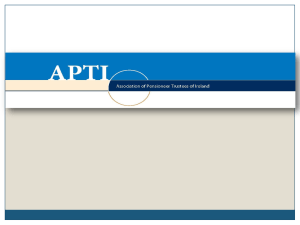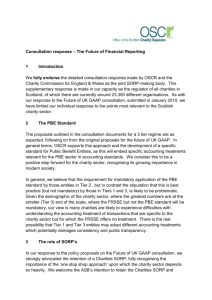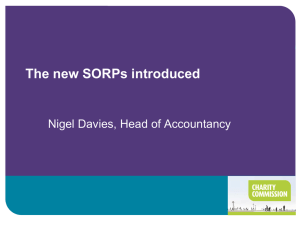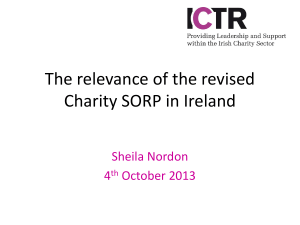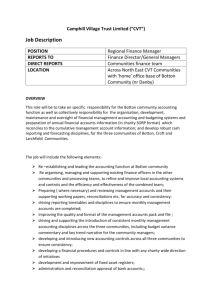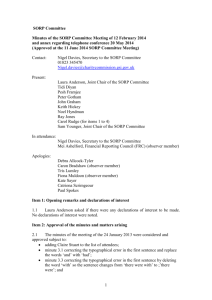- Diocese of Exeter
advertisement
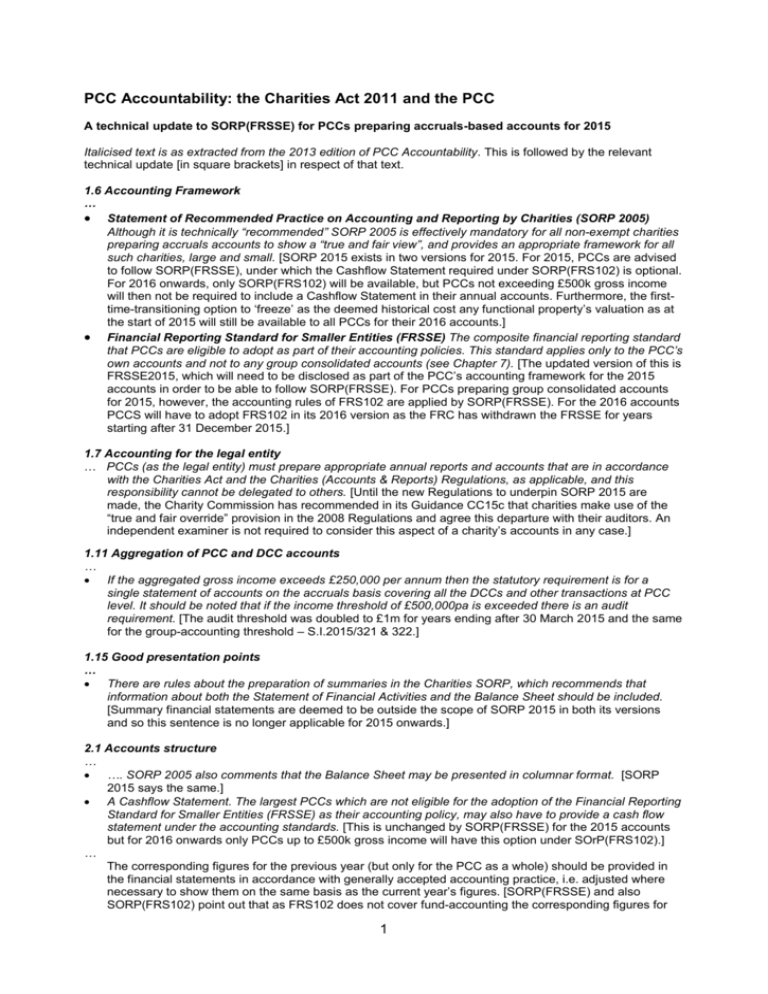
PCC Accountability: the Charities Act 2011 and the PCC A technical update to SORP(FRSSE) for PCCs preparing accruals-based accounts for 2015 Italicised text is as extracted from the 2013 edition of PCC Accountability. This is followed by the relevant technical update [in square brackets] in respect of that text. 1.6 Accounting Framework … Statement of Recommended Practice on Accounting and Reporting by Charities (SORP 2005) Although it is technically “recommended” SORP 2005 is effectively mandatory for all non-exempt charities preparing accruals accounts to show a “true and fair view”, and provides an appropriate framework for all such charities, large and small. [SORP 2015 exists in two versions for 2015. For 2015, PCCs are advised to follow SORP(FRSSE), under which the Cashflow Statement required under SORP(FRS102) is optional. For 2016 onwards, only SORP(FRS102) will be available, but PCCs not exceeding £500k gross income will then not be required to include a Cashflow Statement in their annual accounts. Furthermore, the firsttime-transitioning option to ‘freeze’ as the deemed historical cost any functional property’s valuation as at the start of 2015 will still be available to all PCCs for their 2016 accounts.] Financial Reporting Standard for Smaller Entities (FRSSE) The composite financial reporting standard that PCCs are eligible to adopt as part of their accounting policies. This standard applies only to the PCC’s own accounts and not to any group consolidated accounts (see Chapter 7). [The updated version of this is FRSSE2015, which will need to be disclosed as part of the PCC’s accounting framework for the 2015 accounts in order to be able to follow SORP(FRSSE). For PCCs preparing group consolidated accounts for 2015, however, the accounting rules of FRS102 are applied by SORP(FRSSE). For the 2016 accounts PCCS will have to adopt FRS102 in its 2016 version as the FRC has withdrawn the FRSSE for years starting after 31 December 2015.] 1.7 Accounting for the legal entity … PCCs (as the legal entity) must prepare appropriate annual reports and accounts that are in accordance with the Charities Act and the Charities (Accounts & Reports) Regulations, as applicable, and this responsibility cannot be delegated to others. [Until the new Regulations to underpin SORP 2015 are made, the Charity Commission has recommended in its Guidance CC15c that charities make use of the “true and fair override” provision in the 2008 Regulations and agree this departure with their auditors. An independent examiner is not required to consider this aspect of a charity’s accounts in any case.] 1.11 Aggregation of PCC and DCC accounts … If the aggregated gross income exceeds £250,000 per annum then the statutory requirement is for a single statement of accounts on the accruals basis covering all the DCCs and other transactions at PCC level. It should be noted that if the income threshold of £500,000pa is exceeded there is an audit requirement. [The audit threshold was doubled to £1m for years ending after 30 March 2015 and the same for the group-accounting threshold – S.I.2015/321 & 322.] 1.15 Good presentation points … There are rules about the preparation of summaries in the Charities SORP, which recommends that information about both the Statement of Financial Activities and the Balance Sheet should be included. [Summary financial statements are deemed to be outside the scope of SORP 2015 in both its versions and so this sentence is no longer applicable for 2015 onwards.] 2.1 Accounts structure … …. SORP 2005 also comments that the Balance Sheet may be presented in columnar format. [SORP 2015 says the same.] A Cashflow Statement. The largest PCCs which are not eligible for the adoption of the Financial Reporting Standard for Smaller Entities (FRSSE) as their accounting policy, may also have to provide a cash flow statement under the accounting standards. [This is unchanged by SORP(FRSSE) for the 2015 accounts but for 2016 onwards only PCCs up to £500k gross income will have this option under SOrP(FRS102).] … The corresponding figures for the previous year (but only for the PCC as a whole) should be provided in the financial statements in accordance with generally accepted accounting practice, i.e. adjusted where necessary to show them on the same basis as the current year’s figures. [SORP(FRSSE) and also SORP(FRS102) point out that as FRS102 does not cover fund-accounting the corresponding figures for 1 the previous year in respect of the SoFA’s fund-accounting columns must be shown either on the face of the SoFA or else “prominently” in the accounts notes. The latter can be achieved by copying the previous year’s SoFA into the accounts notes but omitting its comparative figures column – subject to any changes that may be needed for comparability, of course.] 2.3 Accounting policies ... The ‘accounting policies’ note to the financial statements should therefore disclose that the financial statements are prepared under the current Church Accounting Regulations and in accordance with the current Charities SORP and applicable accounting standards (for 2015 onwards, this is expected to become just the current FRSSE for all but the very largest PCC’s, which will have to follow FRS102). [Until new Regulations are made this will require the use of the “true and fair override” recommended by the Charity Commission to enable the PCC to follow SORP 2015 instead of SORP 2005. A PCC can adopt SORP(FRSSE) for its 2015 accounts if qualifying as a “small” within the meaning of the Companies Act 2006 as amended by S.I.2015/980 in respect of the increase in thresholds from £6.5m and £3.26m to £10.2m and £5.1m. For 2016 onwards, however, SORP(FRSSE) is no longer valid and SORP(FRS102) disapplies FRS102’s Section 1A for all its reliefs based on the “small companies regime”, so that only a charity up to £500k gross income qualifies for the SORP’s reliefs for “smaller” charities. ] Model set of accounting policies p.14: Recognition of income and endowments: [Under FRS102, criterion (2) changes from “ultimate receipt is virtually certain” to “an inflow of economic benefit is probable” – see also pages x … z.] p.15: Recognition of liabilities [Similarly, under FRS102, liabilities are recognized as soon as “an outflow of economic benefit is probable” instead of only when “the legal or constructive obligation arises”, which could make some grants payable accruable somewhat earlier than under SORP 2005.] p.16: Tangible fixed assets for use by the charity … “No depreciation is provided on buildings as the currently estimated residual value of the properties (discounted for monetary inflation since their capitalisation) is not less than their carrying value and the remaining useful life of these assets currently exceeds 50 years, so that any depreciation charges would be immaterial. If the carrying value of the buildings looks greater than their current value on this basis, an impairment review would be carried out and any resultant loss included in expenditure for the year.” [SORP(FRSSE), module 12.5, is more prescriptive here regardless of the rate of depreciation: “At each reporting date an assessment must be carried out of whether there is any indication that an asset should be written down (i.e. whether its carrying amount is more than its recoverable amount). If there is no indication that an asset should be written down, it is not necessary to estimate the recoverable amount.”] 2.9 Transactions with members of the PCC and [other] related parties Where a PCC enters into any material transaction, contract or other arrangement (including a grant or donation) with any related party, the amounts involved and the terms and conditions should be disclosed in the notes to the financial statements. Certain transactions need not be disclosed. [SORP(FRSSE), module 9.4, has reduced to zero the level at which any Related Party transaction can be disregarded as immaterial: “A transaction involving a trustee or other related party must always be regarded as material regardless of its size.” For this purpose, the SORP’s glossary has widened its definition of a “Related Party” of the reporting charity by including a donor of land at any time, but no longer includes (i) a seconded employee’s employer if not already a Related Party and likewise (ii) any non-charitable trust from which a trustee could benefit. It should be noted here that for 2016, FRS102 requires disclosure of the total of all donations made to the PCC by related parties, trustees included (which would also include any trustee-expenses foregone, this being just another class of gift-in-kind), unless immaterial, regardless of whether any individual Related Party transactions have to be disclosed.] 2.10 Employee emoluments The total staff costs showing the split between gross wages and salaries, employer’s national insurance costs and pension costs and the average number of employees for the year, should be disclosed in the notes to the financial statements. Clergy paid through the diocese are not PCC employees. If a PCC is over the audit threshold then the notes should also show the number of employees (if any) whose emoluments for the year fell within each band of £10,000 from £60,000 upwards. [Under SORP(FRSSE), module 9.27-9.31, all charities above £500k gross income or otherwise “reporting on an activity basis” (ie, 2 not showing staff costs separately in the SoFA) must provide this accounts note. The pension costs must be split between the employer-costs of Defined Contribution schemes and the operating costs (other than finance costs) of Defined Benefit schemes and the total cost of any other forms of employee-benefit must be shown separately, as must also the total of any staff redundancy/termination costs for the year. Any costs of staff whose employment contracts are with a related party must be included. The employee numbers must be the average headcount but full-time equivalents can be shown as well as can staff deployment by activity-type. Regardless of charity size or classification of expenditure in the SoFA, the numbers of employees of the PCC with “total emoluments (excluding employer pension costs)” in each £10k bracket from £60k upwards must also be disclosed or else the fact there were none must be stated. (For 2016 onwards, under SORP(FRS102), module 9.32, all “larger” charities (those above £500k gross income) must disclose “the total amount of any employee benefits received by trustees and … key management personnel” for their services to the charity. This will remain optional for “smaller” PCCs, but meanwhile consideration needs to be given to identifying who are the “key management personnel” who are required to report back to the trustees in respect of any delegated decision-making powers, eg, on the day-to day management of the PCC, if their aggregate remuneration will now be in the public domain.)] 2.13 Support Costs For the vast majority of PCCs support costs will be for church running expenses and there will be no need to allocate them across different expenditure categories. For PCCs above the audit threshold however, support costs must be allocated to the relevant activity cost categories they support. Support costs are those incurred in undertaking an activity that, whilst necessary to deliver an activity, do not themselves produce or constitute the output of the charitable activity. Similarly, costs will be incurred in supporting income generating activities such as fundraising, and in supporting the governance of the charity. [Under SORP(FRSSE) this applies to all PCCS above £500k gross income or otherwise “reporting on an activity basis”. However, they no longer have to show “governance costs” separately in the SoFA but instead must include them in support costs as a separate category.] Principles of Trust Fund Accounting p.23 (3.3: Applying the tests in practice) [In the penultimate paragraph it should be noted that the gross income threshold for mandatory group consolidated accounts was doubled from £500k to £1m for year-ends after 30 March 2015.] 3.11 Accounting for different types of fund … SORP 2005 makes it clear that funds may be grouped and sub-analysed by major fund in the notes to the financial statements, and so all endowments may be reported on as one group, all other restricted funds as another group and all funds with no restriction as a third group. [SORP(FRSSE) does not change this but points out that FRS102 does not deal with fund accounting by charities. Whilst this has no impact on the 2015 accounts under the FRSSE, which allows charities to continue their existing accounting policies except where new kinds of transaction are undertaken, for which the accounting policy adopted must comply with FRS102, all PCCs accounts for 2016 onwards, being under FRS102, will be subject to the rules of FRS102 and therefore - unlike the 2015 accounts and before - must include fund-accounting comparatives for all figures shown in the SoFA, albeit SORP(FRS102) will allow this to be done in a “prominent” accounts note if not by inserting extra columns in the SoFA itself. See also 4.7, below.] 4.1 Format (of the SoFA) … SORP 2005 requires that charities over the audit threshold should analyse their incoming resources and resources expended by activity according to the purpose of that activity. The SORP also provides (appendix 5.3) that charities below the audit threshold may use any analysis of incoming and outgoing resources that may be best suited to their circumstances. [The format requirements of SORP(FRSSE) are broadly similar to those of SORP 2005 but apply to all PCCS above £500k gross income instead of to all “auditable” charities, as hitherto. The same point about the freezing at £500k of the SORP’s definition of “smaller charity” is to be noted in the introduction to Chapter 4 and in various other places, such as 4.3, 4.19, etc. This includes also the new SORP’s slight changes of terminology, eg, “Incoming Resources” is now “Income and Endowments”, “Resources Expended” is now “Expenditure”, “Governance Costs” are no longer a separate line in the SoFA but are subsumed within “Support Costs” and separately stated only in the accounts notes, and so on. ] 3 4.7 Comparative figures In the SOFA, corresponding amounts for the previous year are required only in total for all funds on each line, but it may help the reader if it is shown fund by fund wherever separate supporting movement statements are provided elsewhere (i.e. by way of note) for any of the underlying funds. [The same applies for 2015 under SORP(FRSSE), but not for 2016 onwards, when all PCCs accounts, being under FRS102, must include fund-accounting comparatives for all figures shown in the SoFA, albeit SORP(FRS102) will allow this to be done in a “prominent” accounts note if not by inserting extra columns in the SoFA itself. See also 3.11. Compliance can most easily be achieved by including a copy of last year’s SoFA (without its comparative figures column) in this year’s (ie, 2016 onwards) accounts notes after making any adjustments needed to show them on the same basis as this year’s SoFA figures.] 4.8 Recognition (of income &c) in the Statement of Financial Activities Members of the PCC have a legal duty to take reasonable care that everything they are entrusted with is properly applied, which in first place means safeguarding everything to which the PCC becomes entitled as soon as this entitlement becomes legally enforceable. This includes not only actual receipts of the year but also any money or other property – whatever its source or purpose – which could have been received if the PCC had exercised its legal right to take possession of it. It should be accounted for as incoming resources of the PCC for the year. The value of all resources – both for income and endowment funds – accruing to the PCC should be recorded in the Statement of Financial Activities as soon as it is practicable to do so. In all cases incoming resources should be recognized as and when the following three accounting requirements are met: (a) entitlement – normally arises when a particular resource is receivable or the PCC’s right to it becomes legally enforceable (unless its utilisation by the PCC has been deferred by the donor); (b) certainty – when there is reasonable certainty that the incoming resource will ultimately be received; (c) measurement – when the monetary value of the incoming resource can be measured with sufficient reliability. [Module 5.9 of SORP(FRSSE) says income must only be recognised in the accounts of a charity when the criteria of (a) “entitlement” (which it says means that “control over the rights or other access to the economic benefit has passed to the charity”) and (c) “reliable measurement” are met (which it now says includes also that “the costs incurred for the transaction and the costs to complete the transaction can be measured reliably”) and (b) “probable – income is recognised when there is sufficient certainty of receipt (receipt is more likely than not)”. This last criterion reflects the wording of FRS102, section PBE34B.5, for recognising legacies: “when it is probable that the legacy will be received”. (See also 4.13: Legacies) That in turn interprets for Public Benefit Entities the generalised accounting recognition criteria set out in FRS102, section 2.27: “Recognition is the process of incorporating in the statement of financial position or statement of comprehensive income an item that meets the definition of an asset, liability, equity, income or expense and satisfies the following criteria: (a) it is probable that any future economic benefit associated with the item will flow to or from the entity; and (b) the item has a cost or value that can be measured reliably.” Module 5.2, however, after saying that SORP(FRSSE) “reflects current accounting practice for non-exchange transactions”, goes on to advise: “Charities should also have regard to paragraphs 34.64 to 34.74 of section 34 of FRS 102 and Appendix B to section 34 of FRS 102 when developing their accounting policies for the recognition of non‑exchange transactions.” All of which means that PCCs will need to give careful consideration to how, if at all, these new, globally based, accounting rules affect the amounts that, under their existing accounting policies for recognising income and incoming endowments, should be shown in the 2015 SoFA.] 4.9 Gifts in kind … In all cases the amount at which gifts in kind are brought into account should be either a reasonable estimate of their value to the PCC or the amount actually realized. [However, SORP(FRSSE) now says this applies only to donated services and facilities. Module 6.9 says: “The FRSSE specifies that donated tangible fixed assets are recognised at their current value (i.e. the lower of replacement cost and recoverable amount). This SORP requires that other donated goods must be measured at their fair value, unless it is impractical to measure reliably the fair value of donated item(s).” According to FRS102, this means “the price that the entity would have to pay on the open market for an equivalent resource”, failing which it says “a value may be derived from sources such as (a) the cost of the item to the donor; or (b) in the case of goods that are expected to be sold, the estimated resale value after deducting the cost to sell the goods.] 4 5.6 Land and Buildings The parish have maintenance responsibility for the consecrated land/buildings and certain other (benefice) properties within the parish. The Charities Act 2011 states in Section 10(2) that benefice property (subsection (a) and consecrated property (sub-section (c)) are removed from the definition of charity for the purposes of the Act. Therefore these assets should not be included in the financial statements though they may be referred to in the notes. Costs associated with the maintenance or improvement of such assets will be written off in the year they are incurred. This exclusion includes the parsonage house. [Trust law’s concept of inalienability and even (given the elevation of “substance over form” as the fifth in FRS102’s hierarchy of nine “qualitative characteristics of information in financial statements” in its section 2.8 saying: “Transactions and other events and conditions should be accounted for and presented in accordance with their substance and not merely their legal form.”) perhaps also the Charities Act’s 50-year old exclusion, in deference to ancient ecclesiastical law, of consecrated property from its definition of “charity”, receive short shrift from FRS102. As the new SORP’s module 6.12 says: “The terms of a gift may require the charity to make on-going use of the donated item, so preventing its sale. In such instances, there may be costs involved in removing such a restriction before the asset could be sold. This would be reflected in a lower assessment of the fair value amount than if the use of that asset was not so restricted.”] Land and buildings can be left at cost or re valued to “current value”. If a revaluation policy is adopted it must be for all assets within that asset-class, with the carrying values updated on a regular basis, and the trustees may use any reasonable approach to valuation at least every five years, with reviews in between to consider if there have been any material changes. [There is no real change here under SORP(FRSSE) for the 2015 accounts, nor under FRS102* (other than terminology: “fair value” replaces “current value”) – except for FRS102’s “first-time transitioning option” available for the 2016 accounts. This will allow the PCC to “freeze”, as a substitute for the actual historical cost, an individual functional fixed asset’s 31 December carrying value in the 2014 accounts or, optionally, its fair value as at 1 January 2015. This may be of some interest for functional properties of significant value not adequately reflected in the Balance Sheet or whose carrying value is costly to update annually in terms of the administrative effort entailed.] Building and leasehold properties will need to be depreciated over their estimated useful lives in accordance with a disclosed policy. A policy of non-depreciation can only be adopted if both the annual depreciation charge and the accumulated depreciation are immaterial to the financial statements, due to the asset having a very long remaining useful life (i.e., 50 years or more), and/or the estimated residual value (discounted for price-inflation since the date of acquisition) is high. If no depreciation is charged, on the basis of immateriality, then an impairment review may need to be undertaken annually. [Regardless of the PCC’s depreciation policy here, SORP(FRSSE) module 12.5 says: “At each reporting date an assessment must be carried out of whether there is any indication that an asset should be written down (i.e. whether its carrying amount is more than its recoverable amount). If there is no indication that an asset should be written down, it is not necessary to estimate the recoverable amount.” Although the point is not highlighted in SORP(FRSSE), the assessment of residual value under FRS102 (on which the SORP is now based in terms of “methods and principles”) has changed significantly. As the glossary to FRS102 says, the “residual value” is: “The estimated amount that an entity would currently obtain from disposal of an asset, after deducting the estimated costs of disposal, if the asset were already of the age and in the condition expected at the end of its useful life.” This means pretending that the building in question is not fit for purpose as far as the PCC is concerned but has been maintained in good order up to the year-end, and then estimating the price an informed purchaser would pay for that building as it stands, plus its land. After stripping out that land value (as non-depreciable), the building’s residual value for depreciation purposes will normally be considerably higher than when it had to be assessed by reference to prices ruling at the time of its acquisition or last revaluation. This could in turn significantly reduce annual depreciation charges, going forward.] 5.10 Current liabilities and long term liabilities Current liabilities include loans and overdrafts, trade creditors, amounts owed to subsidiary undertakings, other creditors and accrued expenses and deferred income. They should be recognised on the balance sheet at their settlement value. Amounts due after more than one year should be separately disclosed. Chapter 6 The Annual Report References to SORP 2005 are superseded by SORP(FRSSE), though in most cases with no change in thereporting requirements - except for the items noted below. It is also necessary to disregard “audit” in references to the audit threshold of £500k gross income. Whilst this is doubled to £1m for year-ends after 30 5 March 2015 under the Charities Act 2011, the new SORP defines the larger charity not as one that is subject to a statutory audit but one that exceeds £500k gross income for the year. p.48 The independent examiner or the auditor will need to see at least a draft of the report as a part of their scrutiny of the financial statements. [Whilst this may be acceptable to the former it will not be so to the latter, as the auditor’s report must confirm that there are no inconsistencies between the signed-off annual report and audited accounts.] p.49: read “£500k gross income” instead of all three instances of “audit”. 6.2 Objectives and activities … This should include … an explanation of the strategies and activities that have been adopted to enable the PCC to achieve its objectives. This could provide details of the programmes the church does, such as regular worship services; house groups; women’s, men’s and youth groups; drop-in centres; outreach work; etc. [According to SORP(FRSSE), module 1.37, this disclosure “should” be made by lager charities, but it “may”, of course, also be made by smaller charities.] 6.3 Achievements and performance [All the disclosures in this section are specified for the larger charity by SORP(FRSSE), where module 1.21 requires of smaller charities only that “the report must contain a summary of the main achievements of the charity”.] 6.4 Financial review The report will paint a picture of the financial position of the church which will supplement the financial statements … [More specifically, as a new disclosure requirement for all charities, SORP(FRSSE), at module 1.24, says: ”If, at the date of approving the report and accounts, there are uncertainties about the charity’s ability to continue as a going concern, the nature of these uncertainties should be explained.” The new SORP’s required disclosures about any fund in deficit also extend, at module 1.25, to identifying any “subsidiary undertaking that is materially in deficit, explaining the circumstances giving rise to the deficit and the steps being taken to eliminate the deficit.”] 6.5 Reserves policy PCCs should report the amount of their reserves in the report. [However, this reserves-level disclosure required by SORP(FRSSE) is much more comprehensive and specific for larger PCCs. Module 1.49 says it should: • state the amount of the total funds the charity holds at the end of the reporting period; • identify the amount of any funds which are restricted and not available for• general purposes of the charity at the end of the reporting period; identify and explain any material amounts which have been designated or otherwise committed as at the end of the reporting period; • indicate the likely timing of the expenditure of any material amounts designated or otherwise committed at the end of the reporting period; • identify the amount of any fund that can only be realised by disposing of tangible fixed assets or programme related investments; • state the amount of reserves the charity holds at the end of the reporting period after making allowance for any restricted funds, and the amount of designations, commitments (not provided for as a liability in the accounts) or the carrying amount of functional assets which the charity considers to represent a commitment of the reserves they hold; and • compare the amount of reserves with the charity’s reserves policy and explain, where relevant, what steps it is taking to bring the amount of reserves it holds into line with the level of reserves identified by the trustees as appropriate given their plans for the future activities of the charity.] 6.8 Risk management (see also 6.9 Structure Governance and Management) ... (Larger) PCCs are required to state in their annual report that the major risks to which the PCC is exposed have been reviewed and that systems or procedures designed to manage those risks have been established. [This retrospective declaration (as also included under 6.9 of the Guide) previously required of larger PCCs is now superseded in SORP(FRSSE) by Module 1.47’s more forward-looking “description of the principal risks and uncertainties facing the charity and its subsidiary undertakings, as identified by the charity trustees, together with a summary of their plans and strategies for managing those risks”, as well as “any factors that are likely to affect the financial performance or position going forward”.] 6 6.9 Structure, governance and management [Larger PCCs must include an entirely new disclosure here under SORP(FRSSE)’s Module 1.52: “the arrangements for setting the pay and remuneration of the charity’s key management personnel and any benchmarks, parameters or criteria used in setting their pay”. This is intended to provide the narrative context for the accounts note disclosure of the aggregate cost to the PCC of their “employee benefits”. The PCC will need to give consideration to how large a senior management team should be designated as its remunerated “key management personnel” whose reporting back to the trustees as a body gives them the necessary assurance that proper internal controls are in place for the delegated management of their PCC.] Chapter 7 - Group Consolidated Accounts and Annual Reports This … statutory requirement … applies only to those few PCCs whose combined gross income including all … subsidiaries exceeds the Charities Act current audit threshold of £500,000 for the year. … PCCs adopting the FRSSE as their accounting policy … would have to extend their accounting policies disclosure if preparing group consolidated accounts. … [With the doubling of that threshold to £1m for year-ends after 30 March 2015, this will apply to even fewer PCCs for their 2015 accounts under SORP(FRSSE) and for 2016 onwards under SORP(FRS102). These few are required under SORP(FRSSE) to comply with its Module 24 for their group consolidated accounts, and 24.3 says: “A charity applying the FRSSE that prepares consolidated accounts may follow its existing accounting policies provided those policies reflect accepted practice and relevant disclosures are made. This module reflects current practice and should be followed by charities using the FRSSE that do not have existing policies for the preparation of consolidated accounts or whose existing policies do not reflect accepted practice. All charities are encouraged to follow current practice as reflected in this module when preparing consolidated accounts. Charities adopting current practice should refer to section 9 of FRS 102 for more information.” Therefore it is only necessary to add “and section 9 of FRS102 for the preparation of the consolidated accounts” in the Accounting Policies note describing the basis of preparation of the PCC’s accounts, instead of “and other applicable financial reporting standards”.] Parent charities invariably combine their group accounts with their entity accounts in the same publication, as this minimises the paperwork entailed and also allows them to take advantage of the SORP’s non-statutory concession at paragraph 397 to publish their group SOFA without their own (entity) SOFA and instead to report the key figures from the latter as an accounts note. [This concession is no longer even mentioned in SORP(FRSSE), but it is understood that the Charity Commission continues to honour on the above basis the company law concession on which it was based, and in the absence of any published statement to the contrary it is assumed that PCCs will be accorded equivalent treatment when filing group accounts.] Chapter 8 - Independent Examination [On pp.59, 63 & 119, references to the old audit threshold of £500k gross income are superseded for 2015 onwards by the new threshold of £1m; On pp.64, 66, 68 & 69, references to the 2008 Regulations made under the Charities Act 2011 will be superseded in due course by the new Regulations needed to underpin SORP(FRSSE) and SORP(FRS102), but meanwhile are to be regarded as subject to the PCC’s invocation (as recommended by the Charity Commission in its published Guidance CC15c on this matter) of the “true and fair override” at Reg.8(4)(c)/(d) of S.I.2008/629 to justify the PCC’s adoption of the new SORP in place of SORP 2005. This includes Reg.8(7) dispensing with comparatives for all the fund-accounting figures shown in the SoFA; On p.119, the references to sources of “applicable accounting principles” at Reg.16(9) on the forma nd content of group accounts are to be regarded as superseded by referecnes to SORP(FRSSE) and SORP(FRS102).] *SORP(FRSSE)10.34: The “fair value” option for functional fixed assets “Charities should ensure that valuations are sufficiently frequent to reflect material changes in market values. For example, land and buildings might be valued on a rolling basis over a five-year period. The value of land and buildings is usually determined from market-based evidence. However, if the trustees believe that a reliable market valuation is not possible, then the ‘value in use’ to the charity or the depreciated replacement cost of the building should be used. The FRSSE requires valuations of land and building to be undertaken by an experienced valuer although this SORP specifically permits the valuation to be carried out by a trustee or by a member of the charity’s staff who has experience and knowledge of the relevant property market.” 7 Technical notes on FRS102’s accounting rules Long-term Liabilities and Provisions – the “time-value” of money FRS102, section 21.7: “When the effect of the time value of money is material, the amount of a provision shall be the present value of the amount expected to be required to settle the obligation. The discount rate (or rates) shall be a pre-tax rate (or rates) that reflect(s) current market assessments of the time value of money and risks specific to the liability. The risks specific to the liability shall be reflected either in the discount rate or in the estimation of the amounts required to settle the obligation, but not both.” Contingent assets FRS102, section 21.13: “An entity shall not recognise a contingent asset as an asset. Disclosure of a contingent asset is required by paragraph 21.16 when an inflow of economic benefits is probable. However, when the flow of future economic benefits to the entity is virtually certain, then the related asset is not a contingent asset, and its recognition is appropriate.” (See also section 2.38) Disclosures about contingent assets FRS102, section 21.16: “If an inflow of economic benefits is probable (more likely than not) but not virtually certain, an entity shall disclose a description of the nature of the contingent assets at the end of the reporting period, and, when practicable, an estimate of their financial effect, measured using the principles set out in paragraphs 21.7 to 21.11. If it is impracticable to make this disclosure, that fact shall be stated.” 8
